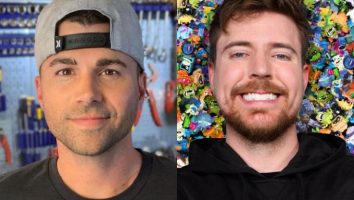PBS has the shows kids want to watch, and kids are tuning in. But up against dedicated kids cable channels-some of which have a significant off-screen presence in kids lives as well (Toon Disney’s theme parks and stores, Nick’s ubiquitous orange splat on merch and films)-PBS needs to become a more recognizable destination for kids by extending its presence and relationship with flagship shows beyond the screen. PBS also needs to generate more revenue to continue its quality programming, given the uncertain financial climate that is part and parcel of public funding.
Brand the puppy, so that every time anyone sees a PBS kid-related property, they get a consistent reminder that the source is PBS-PBS Kids that is. Furthermore, since ancillary revenue is called for, use the new merchandise programs being developed as another platform to promote and reinforce the PBS Kids presence.
New York’s Lee Hunt Associates was called upon to design the PBS Kids branding package. The new brand was launched in September on PBS’s new 24-hour digital kids service (PBS
Kids Channel) and in October on PBS’s daily six-and-a-half-hour Ready to Learn kids block. The PBS Kids branding effort consists of a new logo, interstitials and program packaging, along with a January relaunch of the PBS Kids Web site.
With a 99% penetration in the U.S., PBS plans to take advantage of its national prevalence to let viewers know about PBS Kids. Most of the advertising will take place on-channel, with additional support from radio ads and print ads in parenting pubs slated for January. And as the rebranding will extend to licensing and merchandising efforts, the resulting product will help form a circle that provides a constant visual PBS Kids memory jog as the audience flows from screen to merch to screen.
The goal is to have the new PBS Kids brand everywhere parents are looking for education and entertainment, says Ann Blakey, VP of licensing and distribution for PBS.
The plan for video is to rebrand the library with the new PBS Kids logo, and to add to the already established PBS line distributed by Warner Home Video.
PBS is also looking for ancillary revenue through a nearly completed publishing deal with a major pubco-and not just for programming-based books either. Blakey says there are many types of books suitable for the PBS Kids brand, including bedtime stories and parenting books. Blakey says the books will have a ‘consistent look and feel,’ matching everything else that PBS is doing to compete with kids-only branded channels such as Nickelodeon and Cartoon Network. Blakey hopes that the newly branded PBS books, the first of which should appear in early 2000, will feed on the trust parents and educators have for the PBS brand and in turn, lead them back to the programming. Eventually, possibilities in the toy and game arenas will be explored as well.
Promotions spending has more than doubled to a reported 125% increase over last year for the kids makeover. PBS has also increased its programming budget from a 1998 level of US$144 million to roughly US$154 million. By the year 2000, the programming budget is projected to rise to US$173 million.
According to PBS execs, the key is making the channel a place kids feel comfortable parking the dial, because it already has the quality programming they watch. According to Nielsen ratings, PBS has consistently held a 20% share of the audience of kids ages two to 11 throughout 1997 and 1998. Nielsen data for last July shows PBS holding fast with a 19% share of kids ages two to 11 in the 7 a.m. to 9 a.m. weekday block. PBS also has three of the top-rated preschool shows-Barney, Arthur and Teletubbies.
‘We felt that kids were definitely coming to our shows, no doubt about it, but they weren’t coming to our channel. One might say they’d be just as happy watching our shows on any other service,’ says John Wilson, head of programming for PBS. ‘We definitely want to see this brand deployed in such a way that it is truly organic to everything we’re doing with kids. I want to make sure these popular, beloved characters are associated with the brand in a big way. So that the kids really get where it is they find Arthur and Barney and Teletubbies.’
‘I think what we needed to do was make sure PBS remained relevant in an environment that had changed,’ adds Jane Potenzo, executive director of strategy at LHA. The idea behind the rebranding and the new logo is thinking and imagination. The main logo shows either a boy or girl and a thought bubble that can transform itself into all sorts of ideas and animations. All eight 30-second interstitials created also show the theme of thinking and imagination, with humor thrown in.
One of Potenzo’s favorites is Crazy Belly Dance Party in which a boy goes to the refrigerator to get an ice-cream sandwich and is encouraged by an announcer to eat other, more nutritious food to complement the treat. The next scene shows the inside of the boy’s stomach, where children dressed as fruits and vegetables are dancing to a hot Latin beat.
The program packaging is unique as well. For example, one lead-in to Barney shows a boy and girl walking down a monochromatic street. But soon, everything they encounter turns purple until the entire screen is purple and the Barney logo is shown in the imagination bubble.
The brand-new branding won’t come with the same old programming either. Recently, PBS announced a US$40-million deal with Toronto’s Nelvana to produce six book-based series for a new three-hour Saturday morning block called Ready to Learn This Weekend launching next fall (see ‘Nelvana’s new cash-generating sponsorship plans,’ page 15).
Other new properties include: CTW/
Columbia TriStar’s Dragon Tales, launched this fall, and Between the Lions, co-produced by New York-based Sirius Thinking and WGBH Boston, debuting in spring 2000.





















